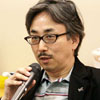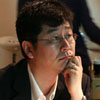 |
|
| |
 |
Coco Funabiki
Chairperson of Jurors, first & second judging
Design Consultant (Japan) |
|
This year's theme has taken into consideration the crisis
that the design world is facing. Last year the committee members responsible
for the theme of the 5th "NAGOYA DESIGN DO!" wavered greatly.
The reason for their wavering was that the design bubble started by the
media has covered all corners of the design world during the last few years.
Designs that make you want to ask, "What on earth is the point of this
design?" are starting to flood the market. By providing the theme "For
Someone Else", the designers designed their entries to fit into society.
This is why this year's entries had a clearer and more understandable message
within them. However, I still don't think that this is enough. I don't think
it is enough to simply present a design that sends a message out to society
or design something that can be used in society.
The reason why I decided to add "Communication and Collaborationモ is
that I saw a need and a wish to communicate with people that come from different
fields and learn from the process of communicating with them. It may not
be possible to grasp a clear image while going through all the works entered,
however I hope that it will be possible during the workshop in Nagoya with
the winners of this competition. |
|
| |
 |
Toyotsugu Itoh
Juror, first & second judging
Graphic designer/Professor, Nagoya Zokei Junior College of Art & Design
(Japan) |
|
Visual design, which I am involved with on a daily basis,
is very closely related to one of the themes of the contest, communication.
The submissions for this contest included that design contest standby, the
poster (with messages directed at all kinds of people) and everyday tools
of various kinds reinterpreted with communication functions (thus giving
actual physical expression to the themes of communication and collaboration).
It was a pleasure to be able to be able to view the works and be involved
in judging them.
The nature of posters and the like is that they are a one-way communication
medium. Certainly, if we consider the theme For Someone Else, the poster
communicates a message well, but it is not clear that the medium is able
to communicate and collaborate in any real way. Though the posters that
won prizes and honorable mentions had strong message content and transmitted
the message well, there was much debate during the judging process about
whether or not they met the requirements of communication and collaboration.
The submission criteria were not stated clearly and the requirements with
respect to the communication and collaboration themes were not always easily
understood. I believe that the submission criteria for the contest should
be laid out in such a way that they are clear to all participants. |
|
| |
 |
Toshiki Kiriyama
Juror, first & second judging
Design producer (Japan) |
|
In my judging, I confirmed and re-confirmed this year's contest
theme many times. "For Someone Else" Communication and Collaborationモ
was a most appropriate theme for our timesムbut the fact that such a theme
proves necessary is a warning about the progress and evolution of humankind.
This was the fifth in the series of Nagoya Design Do! international competitions,
and it was a good competition, fairly judged. It was good that the final
judging panel was open to the public. This process actually helps to nurture
communication. In the old days judging took place behind closed doors, but
now we must learn to debate issues openly. However, our means of communication
are becoming variegated, apart from our individual identities.
I had decided on my personal Grand Prix winner from the first judgingムJacob
Strand Nielson's "HomeUnit". I believe that anybody who loses
their home through the misfortune of an earthquake or fire would want to
at least secure this amount of personal space. The design of the border
between the public and the private spheres is a theme we should seriously
consider for the future. |
|
| |
 |
Nobuho Miyawaki
Juror, first judging
Chief designer, Design Center, General Research Institute of Technology,
INAX Co. (Japan) |
|
| I only participated in the first round of judging, but it
provided me with an excellent opportunity to be reminded once again of the
power of designムthe power of simple yet forceful messages, the power to
show compassion through providing solutions for the disadvantaged. In my
role as a juror, it was my intention to evaluate the works from the creator's
point of view, but the compelling nature of the theme led me to judge the
works emotionally. Our work requires us to consider how people live their
day-to-day lives, and if it is to be useful to anyone, our work as designers
demands that we take the viewpoint of the users of our designs (we must
actually become those people) and solve their problems. The works that were
selected in this contest were all produced with outpouring of passion; they
have uplifted my heart and raised for the future. I look forward with anticipation
to see how the designers from around the world who participated in this
contest will express communication and collaboration in their future work. |
|
| |
 |
Sanja Rocco
Juror, first & second judging
Art director (Croatia) |
|
I find the concept of the "Nagoya Design Do!" competition
very original and motivating for young designers. It was not hard for the
jury to identify the best works, but it was very
hard to decide about the awards.
Concerning the awarded works, their common value is the strong human message.
"Life Alarm" is a great idea for helping people in critical condition
in today's everyday life with lack of communication and interest for other
people's problems. We found out that the "mobile medical container"
could be useful in many different disaster situations throughout the world:
from tsunami, to volcano eruptions and earthquakes, but also in
undeveloped parts where the problem is a lack of medical institutions.
"Matchstick Forrest Poster" series has a strong visual and philosophical
message concerning the environment protection. Among all of the good works,
I would also like to mention two silver awards: "isave" could
be a good approach to make people aware of the need to save water resources.
The "Communication Tape" seems to be such a simple idea, but it
is great because it makes you communicate - with your mother, friend or
partner by putting a personal message to the object you wrap. |
|
| |
 |
Martha Bateman
Juror, second judging
CEO of Martha Bateman Concepts (South Africa) |
|
Japan is a sophisticated country thriving on cutting edge
technology in every area of the economy. The products designed and produced
in Japan have global recognition, having achieved this status. It was very
interesting to observe that the given theme provoked concepts and ideas
for global application. It was indeed not an easy task for the judges to
conclude on exactly the same offerings because of the high standards of
entries, my feeling is that the Grand Pre', gold and silver awards, awarded,
are all very deserving and above all reflected the theme as well as sustainable
designs.
I have approached my task as a juror from a global perspective and kept
the theme in mind, throughout the judging process, measuring back to the
criteria, "For someone else,モ communication and collaboration.
Emanating from the African continent it was important for me to include
the needs of Africa as well as global in my reasoning.
The "Life Alarm" in the product qualification has an implication
for the survival of many human beings universally with cronical conditions
and illnesses. Unnecessary deaths can be prevented. The product speaks for
the theme. My comment is that this product can be improved ergonomically
to improve the aesthetic value and user friendliness.
It has been an honor for me to participate. I wish Nagoya every success
to become the Design City of the future.
|






